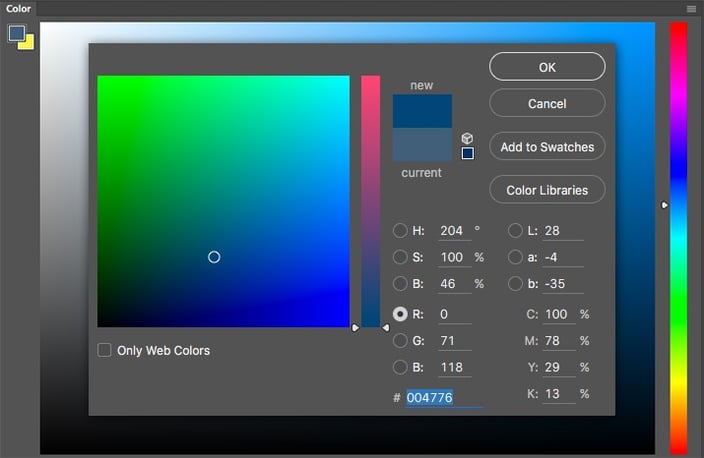
We regularly see questions come in from customers asking if their file needs to be set up with CMYK or if they can send it in RGB. In short, the answer is that either is acceptable. To understand why, however, let’s dig into some of the background and technical elements of these two color models.
CMYK
CMYK stands for Cyan, Magenta, Yellow and Black. These are the four inks used in full-color printing. By combining these four pigments you can simulate almost every other solid color. Using these colors together to create a full-color image is called “four-color process,” so those inks are sometimes referred to as “process inks.”
Why does “K” stand for black? Before cyan became the official name of the standard ink used in color printing, it was simply called blue. So black was identified by the letter “K” to keep the two from getting confused. That terminology persists to this day.
RGB
RGB stands for Red, Green and Blue. These are the three colors of light that, when combined, create every color you can see. Why no black? If you add all the colors of light together, you get white light. Conversely, if you take all the colors away, you get black.
For comparison, when you add 100% Cyan, Magenta and Yellow inks together, you get a muddy dark brown-ish color. For printing processes, a nice dark black is usually preferred, which is why “K” is added to CMYK to achieve black-only elements. Black is the most common (and most readable) color for text as well.
Deciding between CMYK and RGB
Think of it this way – CMYK deals in pigments (i.e. inks); RGB deals with light (i.e. monitors). You have to know the requirements of your medium to know which to use. If you are strictly going to be printing on paper or another substrate and color fidelity is important, you should be working in the realm of CMYK.
Most photo files, being light-based operations, deal strictly in RGB and related formats. To prepare for a printing application, RGB files need to be converted to CMYK at some point. Most designers, wishing to maintain control of their color images, will do the conversion themselves and adjust the color to where they want it. Converting to CMYK should be done as the last step – whether it’s by the designer or the printer.
If the RGB to CMYK conversion will be completed by the printer, they will use standard conversion routines to create a reasonable transformation from one format to the other. Remember that RGB to CMYK is not an exact, one-for-one transfer. You are changing three colors of light to four colors of ink, so some things might get lost in the translation.
To avoid deviating too far from the original colors, many photographers will do all of their color adjustments in the RGB format before translating to CMYK and making final tweaks just before printing. The various image-manipulation software packages will all handle this translation differently, so it’s important to know what you are aiming for and how to get there.
Digital
If your end-use will be digital (i.e. something that will only be seen on a computer screen, phone, tablet, TV, etc.), then keeping your images in RGB makes the most sense. Because these devices all use RGB (and variations of it) to display color, your images will have minimal color variation.
Note: Unlike well-crafted four-color printing, RGB display devices do not all display color the same. Most display devices can be adjusted and calibrated to show better color, but that also means they can be adjusted to display worse color as well. For example, think of all the adjustments you can make to your TV at home based on your personal preference. Now, multiply all those adjustments by every device that could possibly display your photo.
So what do you do if your files will be used for both print and digital mediums? A good example might be a catalog that will be available online, as well as printed and mailed to customers. One option is to create two sets of files if color fidelity is of primary concern. However, if the online display color is of secondary importance, PDF files to display online can be created from the CMYK print files. Just because RGB is primarily used for digital, it doesn’t mean that CMYK can’t be – just know that it won’t be able to show the full range of colors that it could with RGB. Also remember that how an image is displayed online will still vary from device to device, so getting an exact color match to your print catalog will be difficult.
In the end, it’s entirely up to you which color model you use in your design. If you will be printing your finished product, you can send your file as RGB and the print vendor will convert it for you. Or, you can convert it yourself. Doing so will allow you a little more control over adjustments and how your colors are represented. However, you will still be provided a full-color proof from your printer of the converted document, giving you the opportunity to discuss any color changes with them as well.


